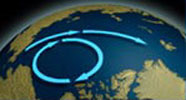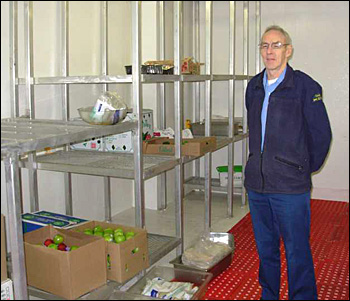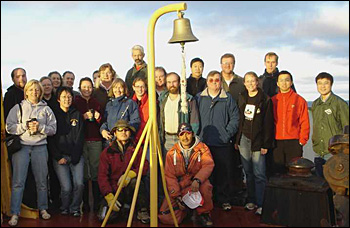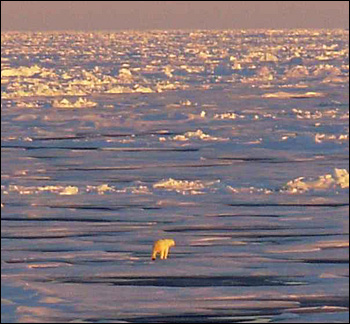Please note: You are viewing
the unstyled version of this website. Either your browser does not support CSS
(cascading style sheets) or it has been disabled. Skip
navigation.
Graham Weldon and Michael Gaudet, Storekeepers, CCGS Louis S. St. Laurent
Each contingent of our scientific team can report significant accomplishments. Seafloor depths were recorded for nearly the entire trip by the Knudsen 3200BR+ sounder, part of the NRCAN program, which also conducted 6 seismic tows for a combined distance of 405 km, sampled to a depth of approximately 5 km. Ice observations from the bridge by UAF scientists were made almost hourly. 6 moorings were recovered and 5 were deployed. For the WHOI moorings as a whole, over 15,000 m of mooring wire and hardware were recovered and replaced, and a total of 1871 mooring days of data were retrieved. The CABOS mooring was also recovered and redeployed. This mooring has made continuous observations of the dissipation of heat in the Atlantic water layer since 2003, and will collect one profile per day for the next year. 11 ice buoys were deployed at three different sites, including 3 from WHOI, 1 CRREL, 1 NPS, and 6 from UAF. Meanwhile, we exploited every possible opportunity for XCTD's, 56 of which collected more than 54 vertical km of salinity and temperature data, and of course for rosette casts: 1230 Niskin bottles (capturing 12,300 liters of water) provided us with 8892 distinct samples from 66 casts that explored more than 117 vertical km of water. Often simultaneously with the rosette casts, we conducted 33 bongo net tows to sample Arctic plankton. Scientists from the Ocean University of China (OUC) also timed their activities to coincide with rosette casts. The OUC scientists were active on three fronts, performing 54 casts of a profiling reflectance radiometer, of which 3 were deployed from the sea ice; logging 170 hours of downwelling solar irradiance measurements on the foredeck; and drawing 85 water samples from the upper 100m of the water column. And, perched high above the bridge on Monkey's Island, looking down over our scientific activities through long summer days that must have seemed endless out in the wind and cold, two wildlife observers looked out for the whales (24), bears (5), seals (9) and birds (258) that every so often crossed our path. By Andrew McNeill, Commanding Officer, CCGS Louis S. St-Laurent I‘d like to congratulate the all of the Scientists, Officers and Crew for their hard work, in making this cruise a success. Through teamwork and perseverance, we were able to overcome a number of challenges. Now we can look back on the last six weeks with pride in our accomplishments. I’d like to give a special thanks to Rick Krishfield for maintaining a detailed account of our adventures. On behalf of the Officers and Crew of the CCGS Louis S. St-Laurent, we trust you have found the dispatches interesting and informative. By Sarah Zimmermann, Chief Scientist, IOS Has it really been six weeks? Wasn’t it just yesterday that we were sitting down looking at the huge program in front of us and now we’re packing up equipment and backing up brand new data from a very interesting field season! It has been a pleasure to be part of this science team and to work on board the CCGS Louis S St-Laurent. The program lead scientist from DFO, Fiona McLaughlin (who wishes she could be out here getting her hands wet) and the DFO science team onboard would like to thank the Coast Guard for their support and especially the Captain and crew of the LSSL who make it all work. We’d also like to thank the Canadian Ice Service and Scott Payment for their assistance with ice images and weather information. Importantly, we’d like to acknowledge DFO and Marty Bergmann for their continued backing of this program. And to those at ‘home’ at the Institute of Ocean Sciences, many thanks for all the help needed to get us out here. By Rick Krishfield, WHOI On behalf of the WHOI mooring team who participated on this cruise (Will Ostrom, Kris Newhall, and myself), and on behalf of the Principal Investigator of the Beaufort Gyre Observing System program, Andrey Proshutinsky, I would like to express our appreciation to the officers and crew of the CCGS Louis S. St. Laurent for once again overcoming all obstacles to ensure that our science program could be accomplished. We also thank all of the scientists who participated on this cruise for making it a wonderful experience, and look forward to continuing these collaborations in the future. I also would like to give special thanks to Chris Linder for his excellent support to convert our raw dispatches into beautiful web pages. And thank you for taking the time to read about our expedition. We hope you will join us again next year. Last updated: October 7, 2019 | |||||||||||||||||||
Copyright ©2007 Woods Hole Oceanographic Institution, All Rights Reserved, Privacy Policy. | |||||||||||||||||||





